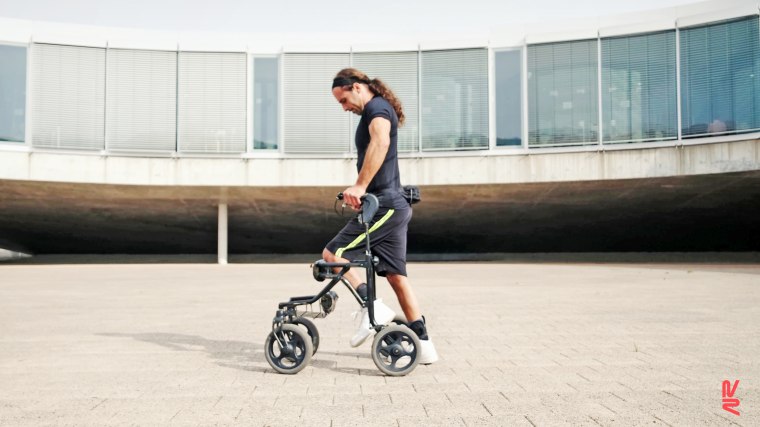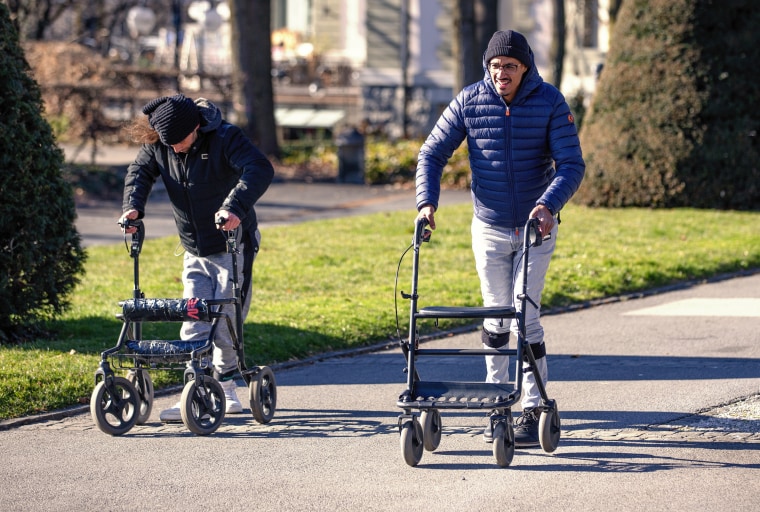Walking Again
"The first few steps were incredible -- a dream come true. It was very emotional to see my legs moving. I've been through some pretty intense training in the past few months, and I've set myself a series of goals.""For instance, I can now go up and down stairs, and I hope to be able to walk one kilometre by this spring.""Every day I work around two hours. I try to improve the quality of the step and the speed. Just by taking a simple shower, I can now stand up.""I am free and I can go and walk wherever I want. I was living with my parents, and now I have an apartment and I can do everything alone, no problem."Michel Roccati, 30, Italy
 |
"When you first turn it on you can stand and step but you still need support, and the gait pattern is poor, but it allows you to start training all this activity immediately, and over the course of several months we can decrease the support.""All three patients were able to stand, walk, pedal, swim and control their torso movements in just one day, after their implants were activated. That's thanks to the specific stimulation programs we wrote for each type of activity.""We are not yet at the stage where it's a commercially available technology that you can use with your smartphone, but that's our next objective.""Our stimulation algorithms are based on imitating nature and work exactly in the way that the spinal cord is stimulated by the brain."
Gregoire Courtine, neuroscientist, Swiss Federal Institute of Technology, Lausanne, Switzerland
Two small remote controls were attached to a walker to help Michel Roccati support himself, a reflection of his years of enforced bodily inactivity caused by the severing of his spinal cord nerves leaving him with a wasted musculature. Attached wirelessly to a tablet to forward the appropriate signals to a pacemaker installed in his abdomen, the pacemaker relays signals to the implant, in turn stimulating specific neurons in a particular sequence which allow the muscles to fire up in correct order, enabling his movement.
 |
A new day is on the cusp of dawning for people with injured spinal cords, bringing them the hope finally of mobility. Michel Roccati was the perfect candidate for this experimental new electronic implant due to his completely paralyzed condition. The electronic implant surgically placed in his spine is renewing his life. Following the implantation of the electronic array to stimulate nerves below his spinal injury, he was able to stand and walk. He can now also cycle and swim.
Partially paralyzed patients were advantaged previously with similar technology, but the work of the Swiss researchers represents the first time this technology has shown itself workable for people whose spinal cord injuries are so severe they have no movement ability whatever. Developed by scientists at the Swiss Federal Institute of Technology and Lausanne University Hospital, the implant is operated through the stimulation of the region of the spinal cord activating specific muscle groups in the trunk and legs.
The principle requirement for the implant to work is six centimetres at the very least, of healthy spinal cord below the site of the injury, to enable the implant to stimulate certain nerves; the implant fitted underneath the vertebrae, within the spinal column. Artificial intelligence is made use of to analyze the sequence of neurons firing in individuals when they intend to carry out activities such as walking, cycling and canoeing.
To stimulate the nerves, the implant uses 15 electrodes, but the researchers aspire to move to 32 or 64 electrodes with the intention of gaining greater control as they expand the effectiveness of their invention. Following the implant surgery, patients recover for roughly ten days prior to the device being switched on.
The technology has been trialled successfully with three other patients whose condition is similar to Mr. Roccati's. Larger clinical trials are planned to take place in the United States and Europe. The Swiss researchers bear hope that their device will become available within the next two to three years. Their research success details were published in Nature Medicine.

Labels: Neural Stimulator Implant, Research, Spinal Cord Injury, Technology

0 Comments:
Post a Comment
<< Home